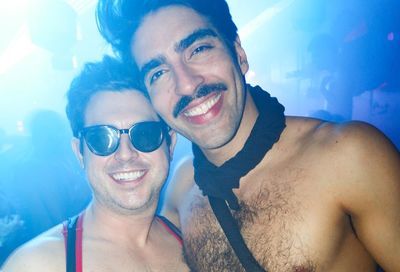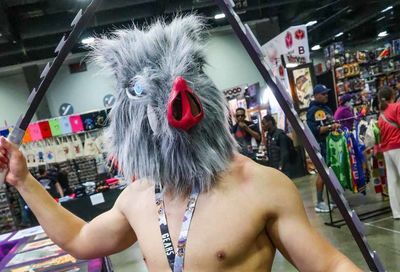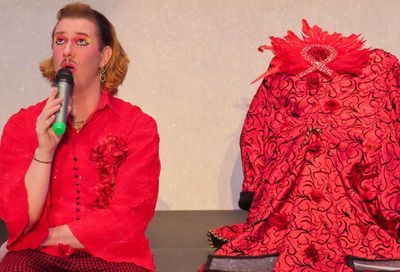Membership's Privileges
The Days and Nights of the Best of Washington
In the mid 1980s, D.C. was hit by one of the biggest snowstorms in its history. Nearly seventeen inches of snow shut down the federal government, closed the schools and forced the cancellation of nearly every scheduled event in the city.
But not the All-Night Strut.
“The city was being buried in snow. Eventually, the police came in and told us we had to shut down, ” remembers Otis Buddy Sutson, Chairman of the Best of Washington.
When that storm barreled through, the Best of Washington had already been throwing parties and pulling political strings for eleven years, but at the advent of the eighties they were in their heyday. They waltzed the same Watergate ballroom floors that had been waltzed upon by U.S. Presidents. They hobnobbed with Marion Barry during both his pre- and post-bust stints as mayor. They drew hundreds of nocturnal movers and shakers to their infamous All-Night Struts. And they did all of this as an archetype of disenfranchisement: an association of gay African-Americans.
 |
Formed in 1972, the Best of Washington did what its members could not do alone — it amalgamated D.C.’s most influential gay black citizens into a single conduit of influence. These socialites, powerbrokers and Washington insiders condensed their clout into one elite channel of power and used it to better the lives of those in the black gay community.
At the time, the black gay community — and for that matter, the gay community at large — wasn’t exactly a political juggernaut. Today, it’s a voting bloc to be reckoned with, and its advancement as a movement has left the Best of Washington with this dilemma: As the barriers of homophobia and racism gradually inch their way down, how does a group like the Best of Washington remain relevant in an age of identity politics?
“Times have changed, ” says Sutson, one of only four remaining members of the group. “The clientele that we used to cater to, they have lots of different options available to them these days. Everybody’s after the black dollar. ”
—
The All-Night Struts began at midnight. Disco music propelled the parties through till sunrise, along with the help of what Sutson candidly calls acid punch.
“It was probably a derivative of LSD, ” says Sutson of the organization’s infamous beverage. “I’m not sure exactly. Whatever it was, it would keep you jumping and dancing all night. ”
The parties drew hundreds of the group’s supporters — politicos and prostitutes, drag queens and doctors, dressed to the nines in the last days of butterfly collars, Afros and platform shoes.
“Many of these girls were prostitutes during the week, ” says Best of Washington President James “Juicy ” Coleman, “but at our events, they got the opportunity to dress up in furs and even perform. The events became a venue for persons to meet other African-American key influencers. ”
Coleman was originally Director of Social Affairs for “The Group, ” the precursor to the Best of Washington. Formed in 1968 by high-profile gay African-Americans and students from Howard University, The Group was the first gay black social club to take its meetings into the public sphere. Eventually, members of the group splintered off and formed the Best of Washington, which upped the ante by brazenly taking its affairs into the city’s high class, high profile hotels.
“Sit-down dinners and formal awards ceremonies — Best of Washington was the first one to have those events, ” says Coleman.
Events like the Watergate Affairs, the more genteel alter-ego of the All-Night Struts. Held at the famous hotel of the same name, the Watergate Affairs were for “wearing our Sunday best and having cocktails, ” says Sutson. “The music was different [than at the Struts], it was black tie, and we were at the Watergate. To me, we were living. ”
Invitations to these exclusive parties were highly coveted.
“When we came together we had our lists of those who we thought should be invited, ” says Sutson. “We had people begging to be a part of it. Being part of the group, you got notoriety. ”
In retrospect, it’s easy to view such a group as an enclave of elitism, but in reality, the Best of Washington formed mainly in response to conditions of racism. Much of the white gay community was no more enlightened than much of America on the subject of race, and blacks had to generate their own alternatives to the gay bars and clubs that deflected them.
“We provided an outlet for the more sophisticated black gay community to attend events where they would be in the company of other black professionals who insisted upon quality entertainment, ” says Coleman. “There were many places in the early eighties where blacks were not welcome — you’d get to the door and they’d ask for fifteen pieces of I.D. ”
In this sense, the Best of Washington wasn’t all that different from other black social groups of the time. What set it apart from other gay groups, however, was its inclusion of the transgender community. Even the idea of having both gay men and lesbians as members was risqué.
“It was a man’s world, ” says Sutson, “but we developed some women who went on to become very powerful. During those times, there were not a lot of venues for gay black men, and there certainly were not a lot for gay black women. ”
Sutson says that originally they were “forced ” to party together out of necessity, but that soon they developed an intimate bond that he feels you don’t find so often these days.
“In today’s world, there are clubs for lesbians and clubs for gay men, ” he says. “There’s no need to be together anymore. I think we were one of the last ones to do that. ”
 |
Bob Lomax, who co-founded the organization with Sutson, ended up marrying one of these lesbians in an attempt to create an image of himself as a family man to advance his political aspirations. The marriage was short lived and Lomax never realized his dream of becoming a politician, but he remained “the driving force ” behind the Best of Washington throughout its zenith, according to Sutson.
“It was his idea that this group was going to excel, and he made sure that it did, ” he says. “It was his baby and he put a lot of work into it. He made it cohesive. He was the glue. ”
Lomax worked for Mayor Barry as the Director of Housing for the District of Columbia, and made sure that the Best of Washington had the mayor’s ear whenever they needed it. During this time, when the notion of an official mayor’s liaison to the gay community was totally absurd, Lomax’s group helped serve the purpose informally.
“Barry came to many of our events, ” remembers Coleman. “In fact, I believe he was best man at Bob Lomax’s wedding. ”
Lomax was among the first victims when the AIDS epidemic throttled the 1980s. When he died, the group lost the guiding hand that, according to Sutson, “held the reigns. ”
“He was a little autocratic, and some people couldn’t deal with that, ” says Sutson, “but he was an energetic guy whose goal was simply to provide excellence in terms of social activities, and that’s what he did. ”
As the first wave of AIDS deaths crested, it took much of the Best of Washington’s clientele with it. The group’s battering from the disease was closely followed by the mainstreaming of gay politics and activism, and declining racism in the gay community. This combination was hard on the group.
“We’ve had periods when we were rather dormant since Bob passed away, ” says Coleman.
Sutson is even more direct.
“It’s a different world. There’s less need for organizations like ours, ” he says. “We give parties still, but it’s no longer our main focus. Now we do a little traveling with our clientele. We’re philanthropic. So I think being able to make that transition has been the key to our survival. ”
Today, one of the group’s biggest events is the Alice Awards, a tradition carried down from their earliest years. Named for Lomax’s mother, the awards are presented annually to individuals and groups who have exhibited excellence and influence in the gay black community. Though many of the Best of Washington’s functions may have lessened, the awards are still attended by hundreds and are considered a laudable honor.
The four members of the group’s board, which used to fluctuate between fifteen and twenty members, are now over fifty years old. Their monthly meetings now mainly take place in the privacy of their homes. And unlike the All-Night Strut that powered through the snowstorm twenty years ago, the meeting they had scheduled two weekends ago was cancelled due to the blizzard.
Sutson worries that there is “not a big need for this type of organization ” in the lives of today’s youth.
“The biggest challenge for me is to pass the torch to the younger generation, ” says Sutson. “We did some heavy recruiting three or four years ago, but soon they got disenchanted and left. Youth these days are growing up in a different time, and we can’t seem to establish a bridge. Being part of the group was a great experience for me, and I want to pass it along. ”
Support Metro Weekly’s Journalism
These are challenging times for news organizations. And yet it’s crucial we stay active and provide vital resources and information to both our local readers and the world. So won’t you please take a moment and consider supporting Metro Weekly with a membership? For as little as $5 a month, you can help ensure Metro Weekly magazine and MetroWeekly.com remain free, viable resources as we provide the best, most diverse, culturally-resonant LGBTQ coverage in both the D.C. region and around the world. Memberships come with exclusive perks and discounts, your own personal digital delivery of each week’s magazine (and an archive), access to our Member's Lounge when it launches this fall, and exclusive members-only items like Metro Weekly Membership Mugs and Tote Bags! Check out all our membership levels here and please join us today!




















